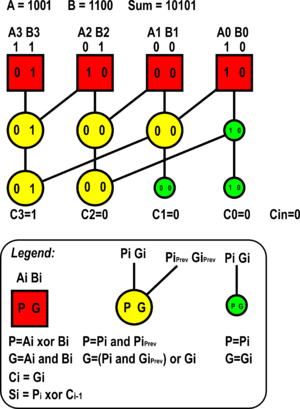
Kogge-Stone Adder
Encyclopedia

Carry Look-Ahead Adder
A carry-lookahead adder is a type of adder used in digital logic. A carry-lookahead adder improves speed by reducing the amount of time required to determine carry bits...
. It generates the carry signals in O(log n)
Big O notation
In mathematics, big O notation is used to describe the limiting behavior of a function when the argument tends towards a particular value or infinity, usually in terms of simpler functions. It is a member of a larger family of notations that is called Landau notation, Bachmann-Landau notation, or...
time, and is widely considered the fastest adder design possible. It is the common design for high-performance adder
Adder (electronics)
In electronics, an adder or summer is a digital circuit that performs addition of numbers.In many computers and other kinds of processors, adders are used not only in the arithmetic logic unit, but also in other parts of the processor, where they are used to calculate addresses, table indices, and...
s in industry.
It takes more area to implement than the Brent–Kung adder, but has a lower fan-out at each stage, which increases performance. Wiring congestion is often a problem for Kogge–Stone adders as well.
An example of a 4-bit Kogge–Stone adder is shown to the right. Each vertical stage produces a "propagate" and a "generate" bit, as shown. The culminating generate bits (the carries) are produced in the last stage (vertically), and these bits are XOR'd with the initial propagate after the input (the red boxes) to produce the sum bits. E.g., the first (least-significant) sum bit is calculated by XORing the propagate in the farthest-right red box (a "1") with the carry-in (a "0"), producing a "1". The second bit is calculated by XORing the propagate in second box from the right (a "0") with C0 (a "0"), producing a "0".
The Kogge–Stone adder concept was developed by Peter M. Kogge
Peter Kogge
-Background:Dr. Kogge has been at the forefront of several innovations that have shaped the computing industry over the past three decades. While working on his PhD at Stanford in the 1970s, Dr...
and Harold S. Stone, which they published in 1973 in a seminal paper titled A Parallel Algorithm for the Efficient Solution of a General Class of Recurrence Equations.
Enhancements
Enhancements to the original implementation include increasing the radix and sparsity of the adder. The radix of the adder refers to how many results from the previous level of computation are used to generate the next one. The original implementation uses radix-2, although it's possible to create radix-4 and higher. Doing so increases the power and delay of each stage, but reduces the number of required stages. The sparsity of the adder refers to how many carry bits are generated by the carry-tree. Generating every carry bit is called sparsity-1, whereas generating every other is sparsity-2 and every fourth is sparsity-4. The resulting carries are then used as the carry-in inputs for much shorter ripple carry adders or some other adder design, which generates the final sum bits. Increasing sparsity reduces the total needed computation and can reduce the amount of routing congestion.
Expansion
In a 4 bit adder like the one shown in the picture to the right, there are 5 outputs. Below is the expansion:S0 = (A0 XOR B0) XOR Cin
S1 = (A1 XOR B1) XOR (A0 AND B0)
S2 = (A2 XOR B2) XOR (((A1 XOR B1) AND (A0 AND B0)) OR (A1 AND B1))
S3 = (A3 XOR B3) XOR ((((A2 XOR B2) AND (A1 XOR B1)) AND (A0 AND B0)) OR (((A2 XOR B2) AND (A1 AND B1)) OR (A2 AND B2)))
S4 = (A4 XOR B4) XOR ((((A3 XOR B3) AND (A2 XOR B2)) AND (A1 AND B1)) OR (((A3 XOR B3) AND (A2 AND B2)) OR (A3 AND B3)))

